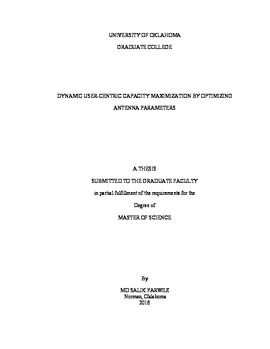| dc.contributor.advisor | Imran, Ali | |
| dc.contributor.author | Parwez, Md Salik | |
| dc.date.accessioned | 2016-09-19T21:39:48Z | |
| dc.date.available | 2016-09-19T21:39:48Z | |
| dc.date.issued | 2016 | |
| dc.identifier.uri | https://hdl.handle.net/11244/45050 | |
| dc.description.abstract | Cellular network has become the primary means of voice as well as data communication. With sophisticated but affordable end user devices e.g. smartphones, tablet PCs etc. and ubiquity of mobile connectivity, users are able to access a range of multimedia services requiring low to high data rate and with desired quality of experience everywhere and all the times. However, mobile network operators (MNOs) always have limited bandwidth resources as compared to users’ demand, as bandwidth is the most expensive resource in the network. Thus MNOs always seek new tools and technologies to optimally utilize the available bandwidth to accommodate maximum number of users and provide high quality of services, maximizing the revenue in return. Especially, in the case of ultra-dense heterogeneous deployment of small cells equipped with massive-MIMO antenna configuration operating over mmWave spectrum in 5G, automated solution for dynamic spectrum optimization with respect to rapidly changing users and network requirement will be of critical importance.
This thesis presents a novel scheme for spectral efficiency (SE) optimization through clustering of users. By clustering users with respect to their geographical concentration we propose a solution for dynamic steering of antenna beam by dynamically adjusting antenna azimuth and tilt angles with respect to the most focal point in every cell that would maximize overall SE in the system. The proposed framework thus introduces the notion of elastic cells that can be potential component of 5G networks. The proposed scheme decomposes large-scale system-wide optimization problem into small-scale local sub-problems and thus provides a low complexity solution for dynamic system wide optimization. Every sub-problem involves clustering of users to determine focal point of the cell for given user distribution in time and space, and determining new values of azimuth and tilt that would optimize the overall system SE performance. To this end, we proposed three user clustering algorithms to transform a given user distribution into the focal points that can be used in optimization process: the first is based on received signal to interference ratio (SIR) at the user; the second is based on received signal level (RSL) at the user; the third and final one is based on relative distances of users from the base stations. We also formulate and solve an optimization problem to determine optimal radii of clusters. The performances of proposed algorithms and framework are evaluated through system level simulations. Performance comparison against benchmark where no elastic cell deployed, shows that a gain in spectral efficiency of up to 26% is achievable depending upon user distribution in each cell. | en_US |
| dc.language | en_US | en_US |
| dc.subject | Engineering, Electronics and Electrical. Telecommunication, Cellular Networks, 5G | en_US |
| dc.title | DYNAMIC USER-CENTRIC CAPACITY MAXIMIZATION BY OPTIMIZING ANTENNA PARAMETERS | en_US |
| dc.contributor.committeeMember | Verma, Pramode | |
| dc.contributor.committeeMember | Chan, Kam Wai Clifford | |
| dc.date.manuscript | 2016-07-14 | |
| dc.thesis.degree | Master of Science | en_US |
| ou.group | College of Engineering::School of Electrical and Computer Engineering | en_US |
